This chapter reviews the livelihoods of different communities according to their predominant source of farm power. The field sites are grouped according to the relative significance of humans, draught animals and tractors as power sources at the beginning of the twenty-first century. The chapter draws on the detailed analysis of the three principal farm-power systems presented in the case studies in Annex 2.
During the fieldwork, communities classified their households according to the principal power source they used for primary tillage (Table 8).
A proportion of households at all sites use hand power for land preparation (except Habru Seftu in Ethiopia). On average, one-third of households in a community rely entirely on family labour for this task but the figure can be as high as 70 percent (in Mwansambo, Malawi). At two sites in west Africa, hired labour rather than family labour is the primary power source.
The use of draught animals is widespread, with only three sites in West Africa never having used them (largely owing to the presence of the tsetse fly). Many households use their own animals but DAP hire is also important (used by 20 percent or more households in four communities).
Tractor use is relatively low, with seven of the 14 sites not using tractors at all at present and only three making any substantial use of motorized power (Sanchitagi, Babatokuma and Mvomero). Tractors are usually hired because few people own them.
TABLE 8
Percentage of households using different sources
of power for primary tillage
|
Field site |
Hand power |
Draught animal power |
Tractor power |
Farming system |
|||
|
Family |
Hired |
Hired |
Own |
Hired |
Own |
||
|
(%)
|
|||||||
|
Predominantly hoe: mixed hand power and DAP communities |
|||||||
|
Mwansambo, Malawi |
70 |
- |
20 |
10 |
- |
- |
Maize mixed |
|
Lodjwa, Malawi |
55 |
- |
30 |
15 |
- |
- |
Maize mixed |
|
K Maracherere, Ethiopia |
50 |
- |
- |
50 |
- |
- |
Highland perennial |
|
Nteme, Zambia |
no data |
no data |
no data |
no data |
- |
- |
Maize mixed |
|
Simupande, Zambia |
no data |
no data |
no data |
no data |
- |
- |
Agropastoral |
|
Predominantly hoe: hand power using hired labour communities |
|||||||
|
Gyangyanadze, Ghana |
27 |
64 |
- |
- |
9 |
- |
Cereal - root mixed |
|
Ojo, Nigeria |
11 |
89 |
- |
- |
- |
- |
Tree/cereal - root |
|
Predominantly DAP communities |
|||||||
|
Habru Seftu, Ethiopia * |
- |
- |
7 * |
93 |
- |
- |
Highland mixed |
|
Kacaboi, Uganda |
15 |
- |
10 |
72 |
2 |
1 |
Maize mixed |
|
Kapchesombe, Uganda |
12 |
9 |
23 |
50 |
5 |
1 |
Maize mixed |
|
Msingisi, United Republic of Tanzania |
15 |
15 |
48 |
12 |
9 |
1 |
Maize mixed |
|
Communities with tractors as significant power source |
|||||||
|
Sanchitagi, Nigeria |
58 |
- |
- |
- |
30 |
12 |
Cereal - root mixed |
|
Babatokuma, Ghana ** |
30 |
- |
8 ** |
2 |
59 ** |
1 |
Cereal - root mixed |
|
Mvomero, United Republic of Tanzania |
55 |
- |
5 |
5 |
34 |
1 |
Maize mixed |
Notes:
No data: percentage data not available for Nteme and Simupande, Zambia: both communities use hand power, hired DAP and own DAP; tractors are not used.
* Habru Seftu: hired DAP represents households which prepare land by sharecropping or occasionally borrowing oxen.
** Babatokuma: the figures for hired DAP and tractors include hiring for transport as well as primary tillage.
Source: Community estimates at field sites.
Three farm-power systems have been identified for grouping communities according to the relative significance of humans, draught animals and tractors as power sources for primary tillage (Table 8):
predominantly hoe-cultivation communities, with two distinct subgroups:
- mixed hand power and DAP: communities where at least 50 percent of households rely on family labour as their sole source of power for preparing the land, and the others use draught animals (either hired or owned);
- predominantly hand power using hired labour: at least 60 percent of the households use hired labour as their principal source of power for land preparation; the others use family labour and a few hire tractors;
predominantly DAP communities: at least 60 percent of households in these communities prepare their land using DAP (usually their own); some households hire tractors and others hire labour, while some only use family labour;
communities with tractors as a significant power source: at least 35 percent of households use tractors for land preparation (usually hired) and many use family labour; DAP is not widely used in these communities.
Figure 4 presents the relative proportions of households in a community using different power sources in these farm-power systems. This classification provides the basis for the livelihoods analysis discussed below.
There are two distinct livelihood systems where humans are the principal power source for all farming operations (full details in Annex 2, Case Study A). One group comprises five communities in east and southern Africa (Kokate Marachere in Ethiopia, Lodjwa and Mwansambo in Malawi, and Nteme and Simupande in Zambia) that once derived most of their power from draught animals but have fallen back on family labour as the main source of power in recent decades. The second covers two communities in west Africa (Gyangyanadze in Ghana, and Ojo in Nigeria) where there have traditionally been few opportunities for mechanization because of the nature of the crops grown (root and tree crops) and hand power is an integral part of the farming system even among richer households.
There is a sharp contrast between the poverty and general depression associated with the predominantly hoe systems of eastern and southern Africa where DAP was once more important, and the hoe communities in west Africa, which are quite vibrant and optimistic in outlook. In the former, the loss of cattle through disease, drought, distress sale or theft has undermined the livelihood strategies for the whole community and has contributed to a drastic decline in agricultural production. Hoe cultivation has become commonplace, resulting in smaller areas under cultivation, reduced total output, reduced cash cropping, increased food insecurity, reduced farm incomes, and a higher incidence of poverty. Households are unable to meet their basic needs from their own cash and in-kind resources. Communities are placed in extremely vulnerable positions and struggle to survive external shocks, such as the drought of late 2002.
|
FIGURE 4
|
The gravity of the situation is exacerbated in communities where the labour base is also under pressure from schooling, migration, ill health or death (particularly from HIV/AIDS). In the study communities in Malawi and Zambia, the capacity to cultivate land by whatever means, rather than access to land, is a significant constraint on production. At Kokate Marachere in Ethiopia, intense population pressure means that land availability is also a constraint.
In the west African communities, the loss of tractor-hire services has also had a significant impact on agricultural activities, but this has been tempered by substituting hired labour for tractors. The sustainability of this response strategy is dependent on the continued availability of hired labour at affordable prices and there are indications that shortages of hired labour may compromise future agricultural production. Again, most households in these communities have access to land that they are unable to cultivate because of shortages of farm power.
The DAP system has long characterized farming in many parts of eastern and southern Africa (full details in Annex 2, Case Study B). Draught animals are currently used by at least 10 percent of the households at 11 of the field sites; some sites made extensive use of DAP in the past but now derive a significant proportion of their farm power from family labour. Draught animals have never been used at three of the sites in west Africa where the natural habitat, tsetse fly, and farming systems mean that these sites are not well suited to DAP.
Within the communities where draught animals dominate primary-tillage activities, there are two distinct subgroups: one group where at least 50 percent of the community own their own draught animals (Habru Seftu in Ethiopia and Kacaboi and Kapchesombe in Uganda); and another where the majority of households hire DAP following the collapse of tractor-hire services (Msingisi in the United Republic of Tanzania). In the former, DAP is an established feature of the farming system and is almost the sole source of power for land preparation. The most extreme example is Habru Seftu in the central highlands of Ethiopia where all the land is prepared by DAP and more than 90 percent of households own draught animals. The community has no experience of tractors and there is no tradition of hoe cultivation on croplands.
Households with access to DAP derive significant benefits. They generally cultivate larger areas than hoe cultivators, realize greater yields, improve household food security, and produce a marketable surplus. However, the ability to reap the full benefits of using DAP for cultivating a larger area than is possible by family labour is only achievable where there is an abundance of labour, especially for weeding.
DAP is increasingly being perceived and promoted by governments and donors as a more sustainable farm-power option than tractor-based systems. Draught animals enable households to reap some of the benefits of improved land preparation without the need to accrue a substantial amount of capital to purchase a tractor or to be dependent on tractor-hire services. However, draught-animal owners require specialist skills and a supporting infrastructure, albeit at a more modest level than that required by tractor ownership.
Nevertheless, DAP is not a panacea. Its application is curtailed by: the presence of tsetse fly; poor soils and steep slopes where deeper tillage may contribute to soil erosion; small plots; partially cleared fields; and a shortage of fodder. DAP households are very vulnerable to the effects of personal misfortune and natural calamities. It is all too easy for DAP communities to revert to hoe cultivation because of livestock disease, cattle theft, and the loss of assets principally due to poverty, illness and the death of key household members. Their ability to recover is frustrated by a shortage of healthy animals, a lack of credit, and the low profitability of agriculture.
Tractors are used by at least 35 percent of the households in three communities (full details in Annex 2, Case Study C). This group comprises one community with a relatively high proportion of tractor ownership (Sanchitagi in Nigeria) and two communities where land preparation is dominated by tractor-hire services (Babatokuma in Ghana and Mvomero in the United Republic of Tanzania). A significant proportion of households in these communities relies on hoe cultivation, more so than in communities where DAP is the dominant power source. Tractors are also used at four other sites but on a modest scale (by 10 percent of the households or less). Some communities used tractors in the past but the services proved unsustainable and they have resorted to hoe cultivation and DAP. None of the sites in Ethiopia and Malawi has used tractors, although hire services are available elsewhere in these countries.
Tractor owners represent the commercial face of farming, using their strong asset-based wealth (often derived from off-farm activities) to purchase inputs such as improved seeds, fertilizer and pesticides. They pay more attention to cash-crop production, either in addition to or in substitution of food crops. Their wealth and role as employers enables them to provide a social net for others in the community who are in a less secure position.
The benefits of using tractors for primary tillage are broadly similar to those of using DAP (in terms of area cultivated, timely and thorough land preparation, and weed control). However, the scale of operation is increased significantly. The benefits are dependent on the availability of labour for subsequent operations and the availability of land for increasing the area under cultivation. To date, neither appears to have acted as a constraint on production. Indeed, the opportunity to earn cash or food through hiring out their labour and land is an essential survival strategy for many hoe cultivators. However, the fieldwork suggests that labour in many communities is becoming scarce as a result of education, migration, ill health and death. As a consequence, labourers are hired from neighbouring communities and further afield. Labour shortages may constrain production in the future.
The viability of tractor power is highly dependent on the profitability of agriculture and the availability and effectiveness of the supporting infrastructure. Under conditions of low farm profitability, the outlook for widespread tractor use must be marginal. Despite the benefits derived from tractor ownership, owners find it difficult to maintain tractors in an operational state because of the weak infrastructure for repairs and maintenance, and the expense. Demand for hire services is falling in many communities where farmers are unable to afford the full economic cost of ploughing or transporting. In some communities, owners are not replacing their tractors and, in others, owners are selling their tractors and reverting to using draught animals.
The last century witnessed considerable changes in the composition of power inputs in agriculture. Many farming communities moved from total reliance on hand power for all operations to making selective use of either draught animals or tractors, or both, for energy-intensive tasks, in particular primary tillage and transporting.
Nevertheless, humans remain the fundamental source of power in all farm-power systems in sub-Saharan Africa, regardless of the power source used for primary tillage. There are three reasons why this situation is likely to persist:
There will always be an element of hand power for land preparation because of the inaccessibility, topography and unsuitability of some soils for mechanization.
Even in communities where draught animals or tractors are a significant power source for primary tillage, at least 20 percent of households rely solely on hand power and, more typically, this proportion is in the region of 50 - 60 percent.
As long as the use of DAP or tractors is confined to primary-tillage operations, the ability to reap their benefits depends on the availability of labour for all other operations.
In the absence of a concerted effort by government, NGOs and the donor community to intervene to address some of the vulnerabilities of various farm-power systems, it is likely that communities where the farm-power base has already been damaged (for example, the former DAP communities in Ethiopia, Malawi and Zambia) will face a continuing state of collapse.
The recovery of the DAP base is not feasible technically in Kokate Marachere (Ethiopia) because of the population pressure on land. Given the high incidence of HIV/AIDS in Malawi and Zambia, it is very likely that the livelihoods in the mixed hand power and DAP communities will deteriorate further as AIDS takes its toll on the agricultural workforce, with estimated losses of at least 14 percent by 2020 (Table 3).
The extent to which the other communities are able to maintain their existing farm-power base, and possibly achieve further mechanization (including mechanization beyond primary tillage), will depend on a number of factors including: the state of their economies and supporting infrastructure; the profitability of farming; and the buoyancy of the rural non-farm economy. Opportunities for agricultural growth may exist in countries where: per-capita incomes are reasonably high and growing (for example, Ghana and Uganda); there is effective demand for agricultural produce from a sizeable urban population (Nigeria); and there is an effective supporting infrastructure (United Republic of Tanzania). However, farmers need security (in particular, land tenure and good governance), the confidence to invest in agriculture and the means to do so. The process of farm-power mechanization could act as a catalyst if it reduces costs and improves returns to investment in agriculture. This may lead to a more commercially-oriented agriculture sector that is more competitive on international markets.
For households entirely reliant on their own labour, it is difficult to move beyond subsistence agriculture in arable crop-production systems. These farmers will need alternative enterprises that are suited to their labour resources, such as animal products or small-scale commercial vegetable production, or opportunities for redeployment in the non-farm sector.

Plate 1
Digging, Ghana.
FAO/18461/P.
Cenini.
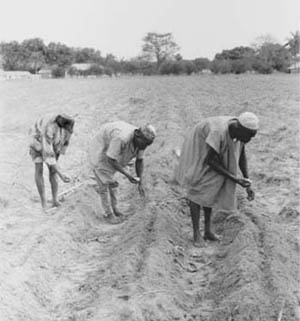
Plate 2
Fertilizing,
Nigeria.
FAO/8074-H-13a/Banoun/Caracciolo.
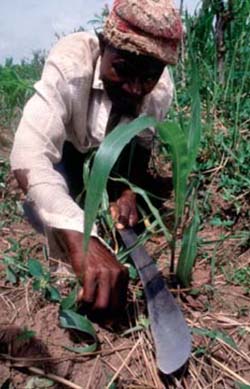
Plate 3
Weeding, Ghana.
FAO/18315/P.
Cenini.
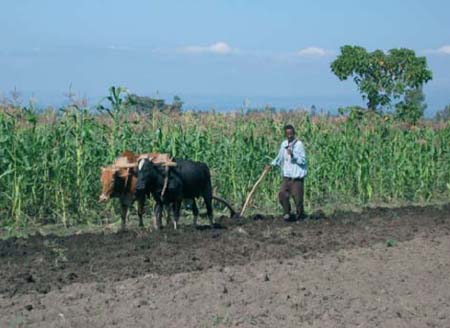
Plate 4
Ploughing with draught animals,
Ethiopia.
FAO/C. Bishop-Sambrook.

Plate 5
Digging, Uganda.
FAO/J.
Kienzle.
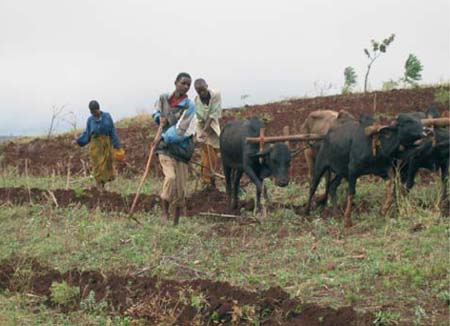
Plate 6
Sowing by hand behind an animal-drawn
plough, United Republic of Tanzania.
FAO/J.
Kienzle.
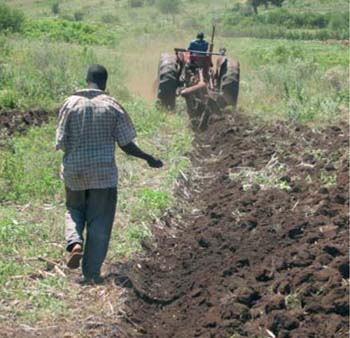
Plate 7
Sowing by hand behind a tractor
disc-plough, United Republic of Tanzania.
FAO/J.
Kienzle.
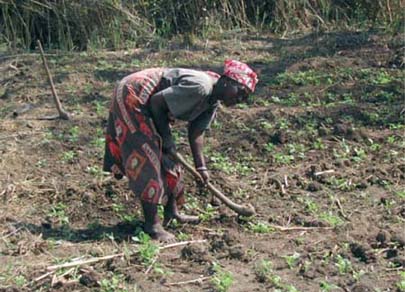
Plate 8
Weeding, Zambia.
FAO/J.
Kienzle.

Plate 9
Irrigating by watering can,
Malawi.
FAO/C. Bishop-Sambrook.